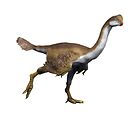Bannykus
| Bannykus Temporal range: Early Cretaceous,
| |
|---|---|

| |
| Holotype displayed in Japan in 2012 | |
| Scientific classification | |
| Kingdom: | Animalia |
| Phylum: | Chordata |
| Clade: | Dinosauria |
| Clade: | Saurischia |
| Clade: | Theropoda |
| Superfamily: | †Alvarezsauroidea |
| Genus: | †Bannykus Xu et al., 2018 |
| Type species | |
| †Bannykus wulatensis Xu et al., 2018
| |
| Synonyms | |
| |
Bannykus is an alvarezsaur from the Early Cretaceous of the Bayin-Gobi Formation of Inner Mongolia, China. It includes one species, Bannykus wulatensis. It is large for an alvarezsaur, with an estimated weight of 24 kg based on femoral circumference.[1]
Discovery[]

The holotype of Bannykus wulatensis is IVPP V25026, a partially-articulated incomplete skeleton. The holotype comes from the Bayin-Gobi Formation in Chaoge, Wulatehouqi, Inner Mongolia, China. It was discovered in 2009 and in 2012, its remains were displayed in Japan under the unofficial name "Wulatesaurus". It was given the binomial name Bannykus wulatensis in 2018; its generic name comes from the Mandarin word Ban (Chinese: 半), meaning half, and the Greek word onyx, meaning claw. This refers to the transitional characteristics seen in this theropod. The specific name refers to Wulatehouqi (Wulate Rear Banner), the county that the holotype was found in.[1]
Classification[]
Bannykus, along with Xiyunykus, fills a 70-million year gap in alvarezsaur evolution by exhibiting morphologies intermediate between the typical theropod forelimb of Haplocheirus and the highly reduced forelimbs and minute teeth of Late Cretaceous alvarezsaurids.
References[]
- ^ a b Xu, Xing; Choiniere, Jonah; Tan, Qingwei; Benson, Roger B.J; Clark, James; Sullivan, Corwin; Zhao, Qi; Han, Fenglu; Ma, Qingyu; He, Yiming; Wang, Shuo; Xing, Hai; Tan, Lin (2018). "Two Early Cretaceous Fossils Document Transitional Stages in Alvarezsaurian Dinosaur Evolution". Current Biology. 28: 2853–2860.e3. doi:10.1016/j.cub.2018.07.057. PMID 30146153.
- Alvarezsaurs
- Fossil taxa described in 2018
- Early Cretaceous dinosaurs of Asia
- Theropod stubs















